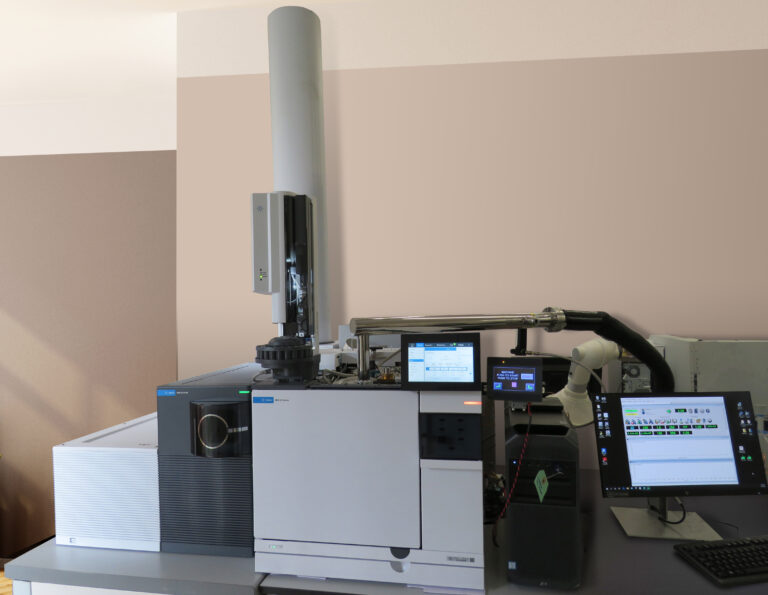
We asked Daniela Peroni, Senior Application Specialist & Internal Lab Manager, how the Agilent QTOF 7250 combined with the GC × GC with Zoex thermal modulator can improve a laboratory's analysis
The recent installation of this platform at the SRA laboratory in Cernusco sul Naviglio has allowed us to further deepen our knowledge of this truly exceptional performance instrument.
THE CONFIGURATION PRESENT IN SRA
In our SRA laboratory in Cernusco sul Naviglio we have recently installed an Agilent QTOF 7250. We are very pleased to have a high-level platform suitable for all those applications that require very high performance. To make this platform even more effective we have paired the Agilent QTOF with a Zoex thermal modulator. Our choice fell on the model with closed circuit refrigeration (without the need for liquid nitrogen) which allows us to contain management costs and to operate 24 hours a day without ever interrupting the acquisition for the refilling of liquid nitrogen, improving the efficiency as well as the ecological impact of the laboratory.
It is important to underline that the QTOF guarantees us an acquisition speed of 50 Hz, sufficient to appropriately acquire the tight and rapid peaks generated by the thermal modulation, without sacrificing in any way the resolution and the accurate mass as per specification.
This platform combines the unique features of QTOF with the excellent separative power of the GC × GC with thermal modulation that guarantees the best possible chromatographic resolution, as well as sensitivity and excellent flexibility of use; these three aspects make the platform the top of the range.
WHAT TYPES OF ANALYSIS ARE POSSIBLE
The investment in this platform offers SRA customers a solution that effectively responds to particularly demanding analytical requests, i.e. when it comes to identifying compounds in extremely complex matrices, characterized by an excessive degree of co-elution for GC-MS. traditional. Furthermore, this platform can prove to be a powerful ally for untarget analysis; we think for example of the need to determine similarities and / or differences in series of complex samples to cluster them on the basis of known characteristics (origin, quality, etc.) as is nowadays required in various fields (food & flavor, fragrances, petrochemicals etc. .). The information-dense data achievable with the GC × GC-QTOF platform can provide a very useful tool for this purpose.
THE QTOF SEEN BY SRA
The QTOF 7250 is without a doubt Agilent’s high-end mass spectrometer, a tool designed for the most complex identification challenges. When the analytical request is beyond the capacity of a single quadrupole, the QTOF can give the answer.
The QTOF is a high resolution time-of-flight mass spectrometer that allows us to discriminate between masses nominally equal but in reality different as they are generated by different formulas. When this difference is evident only at the level of decimal digits, it is not visible with traditional low resolution spectrometers. The QTOF gives us the ability to discriminate between these subtle differences and is able to go up to the fourth decimal in the mass of the ions, providing excellent selectivity. It is possible not only to acquire a characteristic spectral pattern of the molecule, but also to determine what the molecule formula actually is, thanks to the accurate mass (accuracy <2 ppm). This becomes extremely important when I want to confirm as confidently as possible the identity of the molecules of interest or, even more difficult, when I want to reliably identify completely unknown molecules. For this reason, the QTOF is certainly the Agilent detector with the greatest potential for identifications with a high degree of difficulty.
In addition to the mode of use in scanning, which allows us to take advantage of the high resolution TOF to generate spectra with accurate mass, the QTOF allows us to use the quadrupole located upstream to follow MS / MS measurements. In fact, the mass filter placed after the source can be used to select a specific ion, for example what is believed to be the molecular ion, to be subjected to fragmentation again in a collision cell. The high resolution secondary spectrum thus generated can increase the reliability of identification and help with structural elucidation.
Another very interesting feature of the QTOF 7250 is the low-energy ionization, which allows you to perform ionization at low energy, so for example at 14-16 eV. This modifies the fragmentation which will be “gentler”, generating a different spectral pattern which will provide additional information for identification. This can be useful for identifying structural isomers that give the same MS pattern at 70 eV but are characterized by characteristic low-energy spectra that allow them to be distinguished.
This flexibility of use makes the QTOF a unique detector of its kind which, like a Swiss army knife, provides us with a series of tools that combined can help us respond to even the most difficult analytical requests.
WE ARE WAITING FOR YOU IN SRA. The system is installed and operational. we are therefore pleased to offer our customers the opportunity to discover this truly performing platform.
_____________________________________
THE HEAD OF THE LABORATORY SRA
Daniela Peroni earned a Master’s Degree in Analytical and Environmental Chemistry from the University of Padua and, later, a PhD from the University of Amsterdam.
After several years of working experience abroad, in 2020 Daniela joined the SRA Instruments Italia team as an application specialist and manager of the demo laboratory in Cernusco sul Naviglio.
Daniela specializes in gas chromatography and two-dimensional gas chromatography (GC × GC) in combination with mass spectrometry, without forgetting the other analytical techniques to which she pays attention and constant study.



